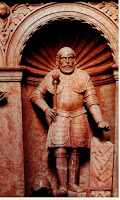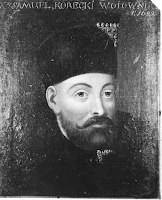Salvete Omnes,
before there was Chocim 1621 there had been the Cecora campaign, Polish invasion of Moldavia that ended in a major disaster for the Commonwealth army and most of its participants - including the heroic death of the commander in chief Stanislaw Zolkiewski and his reiter bodyguard.
The Royal army the marched across the Dniester River into the Moldavian territory;
the army had circa 7,000 horses and portions, divided into a 'pulk ' (temporary divisions) large operational units[1]:
Commander in chief - Crown grand hetman Stanislaw Zolkiewski
(all units identified by the commanders' names)
1 pulk - commanded by the grand hetman de jure, but it was actually commanded by a winged hussar banner captain Makowiecki
- cavalry in total 1,220 lances and horses:
Winged hussar banners:
1. grand hetman banner led by Malynski - 270 lances
2. starost of Chelm Danillowicz - 150 lances
3. starost of Halicz Makowiecki - 150 lances
Pancerni kozak cavalry:
1.starost of Winnica Aleksander Ballaban banner- 150 horses
2. Dworycki/Dworzycki banner - 150 horses
3. voivode of Ruthenia Jan Danillowicz banner -300 horses
4. Wolmar Farensbach banner - 50 horses
Infantry 450 portions
1. Royal court Polish infantry company -300 portions
2. Farensbach's company - 50 portions
3. voivode of Ruthenia Jan Danillowicz's German infantry company - 100 portions
total 1,670 lances, horses and portions
2nd pulk - Crown field hetman Stanislaw Koniecpolski
Cavalry in total - 1,100 lances and horses
Winged hussars banners:
1. field hetman own banner - 200 lances
2. Marcin Kazanowski - 150 lances
3. voivode of Braclaw Potocki - 150 lances
4. Strzyzowski - 150 lances
Reiiters or German pistoliers
1. Herman Denhoff's banner - 200 horses
Pancerni kozak cavalry
1. Odrzywolski (actually commanded by Ujazdowski) - 150 horse
2. Lewikowski - 100 horse
Infantry 430 portions
1. field hetman's own company commanded by Damiecki - 230 portions
2. Rybinski Polish levied infantry- 200 portions
total pulk number of lances, horses and portions - 1,530
3rd pulk -starost of Halicz Mikolaj Strus (famous 'defensoe' of the Kremlin in Moscow in 1611-12)
all Cavalry unit
Winged hussar banners
1.son of voivode of Podolia Sieniawski - 100 lances
2 Malinski - 150 lances
Pancerni kozak cavalry
1. Mikolaj Strus own banner - 100 horses
2. starost of Chmielnik - 100 horses
3. Kowalski - 100 horses
Private volunteers and their retainer - 1500 horses
total pulk number of lances and horses - 2,050
4th pulk - prince Samuel Korecki
Total cavalry numbers - 600 lances and horses
Winged hussars banners:
1. prince Korecki's own banner -150 lances
2. castellan of Kamieniec Podolski - 100 lances
3. Wrzeszcz - 150 lances
Pancerni Kozak banners:
1.prince Samuel Korecki's own - 100 horses
Light cavalry -
Lithuanian? Tatars - 100 horse archers
Infantry companies - total 300 portions
1.Wiadrowski - 200 portions
2.Ujazdowski - 100
Total pulk numbers - 900 lances, horses and portions
5th pulk - starost of Kamieniec Podolski Walenty Kalinowski
total number of lances and horses - 500
Winged hussar banners:
1. starost of Kamieniec Podolski own - 150 lances
2. Firlej - 150 lances
Pancerny Kozak -
1. Kalinski - 100 horses
2. Wachowski - 100 horses
Infantry
1. Starost of Kamieniec Podolski own Polish infantry - 100 portions
2. Starost of Kamieniec Podolski own Ruthenian infantry - 100 portions
total pulk number of lances and horse and portions - 700
Finally, Teofil Szmberg was nominated as the commander of all artillery (16 small field peices and some heavy muskets mounted on wagons ), while Stanislaw Trzebuchowski became the general commander of infantry.
Master of camp/wagon laager was Jan Odrzywolski.
about 3,200 men of this army were the so called 'state soldiers' and under the direct command of the grand hetman, while about 3,600 belonged to the private banners and companies owned and paid for by magnates and lords, esepcially Kalinowski and prince Korecki and their 'vassals' and partisans.
additionally, other private and mercenary units came streaming in to join the marching royal army between the 1 of Spetmeber and 12th of Septmeber, like the 800 soldiers under Stefan Chmielecki, who was a partisan of prince Korecki. Janusz Tyszkiewicz joined the army with 400 Cossacks and 200 infantry.
Then, there were the 12 banners of Lisowski kozaks or Lisowczyks - various sources Hurmuzaki and Miaskowski etc state different numbers, perhaps between1,300 to 1,700 most seasoned horsemen - - under Walenty Rogawskiwith very few retainers if any, but for their commander and officers retinues. They came late on the 11th of September, with a 100 horse banner of Slowinski,, and with another 150 horses banner of prince Zbaraski?.
In total, before the hostilities on the 17th of September the Royal army might have been circa 10,000 lances, horses and portions, and in addition perhaps 8-10,000 camp servants (the infantry was very small in number while cavalry companions relied on their service), that provided for horse fodder, food and herding horses.
On the 2nd and 3rd of September this army, already divided by politics and personal dislikes, crossed te Dniester River, without awaiting the troops coming to join them from the interior of Commonwealth.
On the 7th of September hospodar or prince Graziani join the royal army with as little as 600 Moldavians and mercenary Serbians (Graziani had promised 15,000 troops, but as we can see he failed miserably). Additional 400 Wallachians horsemen led by two captains broke away from the Ottoman command and joined the royal army.
On the 12th of September the entire army reached the old fortified campground near Cecora on the Prut River and on that date perhaps as many as 11,000 thousand lances, horses and portions camped at Cecora war laager. Instead of marching on to contain and besiege the Iskander-Pasha small Ottoman army at Tehinia/Bender, our grand hetman chose to await the enemy at the fortified war laager.
[1] army and war camp organization near the so called 'Gruszka' wilds (12 km east of Mohylev) Sept 1, 1620AD re , Majewski, Cecora, p. 142-45
Valete







No comments:
Post a Comment